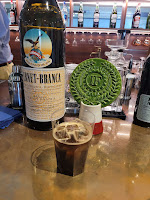Behind every golden drop of olive oil lies a process that blends ancient tradition with modern precision. Much like winemaking or distillation, olive oil production is a balance of art and science — where timing, technique, and terroir determine the outcome. From the grove to the press, each step in the journey shapes the oil’s flavor, aroma, and integrity.
For those in the beverage world, understanding how olive oil is made offers valuable insight into its complexity — and the same appreciation we give to the craftsmanship behind a fine wine or spirit.
Featured Producer
Terre Francescane is located in Umbria and the Gradassi family has been farming olives for 400 years. In 1639, when – according to an ancient inscription found on a stone in the old olive mill – the Gradassi family began farming olives. Four centuries later they still proudly harvest olives from the same fertile slopes their ancestors did. I picked up this bottle of their L'Italiano Black Ceramic at the Rome airport duty free store and wish I had purchased more. It's slightly sweet with a pleasant bitterness at the finish - easy for a teaspoon a day diet.
The Harvest: Timing Is Everything
The olive harvest typically takes place between October and December in the Northern Hemisphere (and April to June in the Southern Hemisphere). The timing of the pick is crucial:
Early-harvest olives are greener, yielding robust, peppery oils with higher polyphenol content (the antioxidants that give structure and bite).
- Late-harvest olives are riper, producing smoother, fruitier oils with a gentler profile and golden hue.
Producers choose their harvest moment based on desired flavor, cultivar, and market style — much like vintners deciding when to pick grapes. In many small groves, olives are still hand-harvested, preserving fruit integrity and reducing bruising before pressing.
From Fruit to Paste: The Milling Process
Once harvested, speed is essential Olives begin to oxidize and ferment quickly after picking, so quality-focused producers rush them to the mill — often within hours.
At the mill (frantoio in Italy or almazara in Spain), olives are washed and ground into a thick paste using hammer or blade mills. This paste contains both oil and water, and the goal is to separate the two while preserving the delicate aromas and flavors.
Malaxation: The Quiet Transformation
After milling, the olive paste is gently mixed in a process called malaxation. This slow churning (usually 20–40 minutes) allows small oil droplets to coalesce into larger ones — a critical step for flavor development. Temperature control here is key: to qualify as cold-extracted or cold-pressed, the process must stay below 27°C (80°F) to prevent flavor loss and preserve antioxidants.
Professionals often compare this stage to maceration in winemaking or blending in distilling — it’s where texture, balance, and character begin to emerge.
Extraction: Separating Liquid Gold
Modern producers use cen, the purest and highest-quality grade, obtained mechanically without chemical refinement or excessive heat.
The remaining byproduct, called pomace, can be repurposed for compost, fuel, or lower-grade oil production, aligning with sustainable agricultural practices.
Storage & Bottling: Protecting Freshness
Fresh olive oil is like fresh juice — vibrant, aromatic, and best enjoyed soon after production. It’s typically stored in stainless steel tanks under nitrogen or inert gas to minimize oxygen exposure and light damage. When bottled, dark glass or tins help preserve quality, and clear labeling ensures transparency on harvest date, origin, and cultivar.
Much like wine, olive oil evolves over time — but rather than aging, it gradually loses intensity. The best producers encourage consumption within 12–18 months of harvest for peak flavor.
Craft in Every Step
From the meticulous timing of the harvest to the precision of cold extraction, making olive oil demands the same attention to detail that defines great winemaking and distillation. For beverage professionals, understanding this process transforms olive oil from a simple pantry item into a crafted product — one that speaks of place, producer, and philosophy.
For travelers, visiting a working mill during harvest reveals a world alive with sensory energy — the hum of machinery, the scent of fresh-cut grass, and the taste of vivid green oil straight from the press. It’s an experience that captures both the science of extraction and the soul of the Mediterranean.



















































